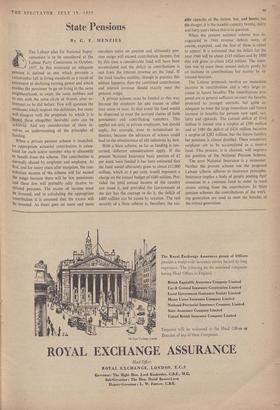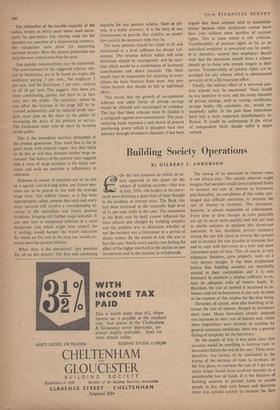State Pensions
By G. F.
MENZIES THE Labour plan for National Super- annuation is to be considered at the Labour Party Conference in October, 1957. In this statement an adequate Pension is defined as one which prevents a catastrophic fall in living standards as a result of retirement or declining earning power and which enables the pensioner to go on living in the same neighbourhood, to enjoy the same hobbies and to mix with the same circle of friends after re- tirement as he did before. Few will question the sentiment which inspires this definition, but many will disagree with the proposals by which it is hoped these altogether desirable aims can be achieved. And any consideration of them in- volves an understanding of the principles of funding.
When a private pension scheme is launched, an appropriate actuarial contribution is calcu- lated for each active member who is ultimately to benefit from the scheme. The contribution is normally shared by employer and employee. At first, and for many years after inception, the con- tribution income of the scheme will far exceed the outgo because there will be few pensioners and these few will probably only receive re- stricted pensions. The excess of income must be invested, and in calculating the appropriate Contribution it is assumed that the excess will be invested. As times goes on more and more members retire on pension and ultimately pen- sion outgo will exceed contribution income, but by this time a considerable fund will have been accumulated and the deficit in contributions is met from the interest revenue on the fund. If the fund reaches stability, though in practice this seldom happens, then the combined contribution and interest revenue should exactly meet the pension outgo.
A private scheme must be funded in this way because the employer for one reason or other may cease to exist. In that event the fund would be dispersed to meet the accrued claims of both pensioners and contributing members. This applies not only to private employers, but should apply, for example, even to nationalised in- dustries, because the advances of science could lead to the obsolescence of old industries by new.
With a State scheme, so far as funding is con- cerned, different considerations apply. If the present National Insurance basic pension of £2 per week were funded it has been estimated that the fund would ultimately grow to about £12,000 million, which at 4 per cent. would represent a charge on the annual budget of £480 million. Pro- vided the total annual income of the country can stand it, and provided the Government of the day has the courage to do it, the deficit of £480 million can be raised by taxation. The real security of a State scheme is, therefore, the tax- able capacity of the nation, but, and herein lies the danger, it is the taxable capacity twenty, thirty and forty years hence that is in question.
When the present national scheme was in- augurated in 1946 revenue deficits were, of course, expected, and the first of these is about to appear. It is estimated that the deficit for the year 1960 will be about £145 million and by 1980 this will grow to about £424 million. The inten- tion was to meet these annual deficits partly by an increase in contributions but mainly by in- creased taxation.
The Labour proposals involve an immediate increase in contributions and a very large in- crease in future benefits. The contributions pro- posed are in general sufficient to meet the benefits promised to younger entrants, but quite in- adequate to meet the large immediate and future increase in benefits for persons now aged, say, forty and upwards. The current deficit of £145 million is turned into a surplus of £380 million and at 1980 the deficit of £424 million becomes a surplus of £282 million, but the future liability for pensions is almost doubled. These temporary surpluses are to be accumulated as a reserve fund. This process, it is claimed, will improve the position of the National Pension Scheme.
The term National Insurance is a misnomer. Neither the present scheme nor the proposed Labour scheme adheres to insurance principles. Insurance implies a body of people pooling their resources in a common fund in order to meet claims arising from the contributors. In State pension schemes the contributions of the work- ing generation are used to meet the benefits of the retired generation. The estimation of the taxable capacity of the nation twenty or. thirty years hence must neces- sarily be speculative, but, leaving aside for the moment any question of a depreciating currency, the calculation must allow for improving national income. Here the present generation can help the next, indeed must help the next.
One popular misconception may be mentioned. The contributions for the suggested scheme, sub- ject to limitations, are to be based on wages, the .employee paying 3 per cent., the employer 5 per cent. and the Exchequer 2 per cent., making in all 10 per cent. This suggests that there are three contributing parties, but there is, in fact, only one—the public. The employer, unless he can offset the increase in his wage bill by in- creased productivity and by reduced profit mar- gins, must pass on his share to the public by increasing the price of his product or service. The Exchequer must raise its share by taxation of the public.
This is the immediate sacrifice demanded of the present generation. They must face a rise in price levels with reduced wages. Are they likely to do this or will they demand further wage in- creases? The history of the postwar years suggests that a wave of wage increases is the likely out- come and such an outcome is inflationary in character.
Pensions in course of payment are to be tied to a special cost-of-living index and future pen- sions are to be geared to rise with the average wage level. This inflator clause, as it has been appropriately called, ensures that each and every wage increase will involve a corresponding in- crease in the immediate and future pension liabilities, bringing still further wage demands. It can only lead to compound inflation of a most dangerous type which might even imperil the :£ sterling, would hamper the export industries by which we live and in the long run would cer- tainly burst the pension balloon.
What, then, is the alternative? Are pensions for all an idle dream? The first and continuing requisite for any pension scheme, State or pri- vate, is a stable .currenCy. It is the duty of any Government to provide that stability no matter how painful the necessary steps may be.
The basic pension should be raised to £3 and maintained at a level sufficient for decent sub- sistence. The revenue deficits which will arise therefrom should be courageously met by taxa- tion which would be a combination of increased contributions and direct taxation. The State would thus be responsible for ensuring to every citizen the basic freedom from want. Any pro- vision beyond that should be left to individual effort.
This means that the growth of occupational schemes and other forms of private savings would be allowed and encouraged to continue. The fact that these schemes must be funded is a safeguard against over-commitment. The accu- mulating funds represent a real denial of present purchasing power which is ploughed back into industry through investment channels. It has been argued that these schemes tend to immobilise labour because older employees cannot leave their jobs without some sacrifice of accrued rights. This to some extent is fair criticism. Transferability of pension rights so far as an individual employer is concerned can be costly. It is, therefore, natural that employers should wish that the maximum benefit from a scheme should go to those who remain longest in their service. Transferability of pension rights can be arranged for any scheme which is administered privately or by a life insurance office.
Finally, the indirect effect of a universal pen- sion scheme may be mentioned. There would be less incentive to save, and the many channels of private savings, such as savings certificates, savings banks, life assurance, etc., would un- doubtedly suffer. In the past these institutions have had a most important disinflationary in- fluence. It would be unfortunate if the virtue of independent thrift should suffer a major setback.















































 Previous page
Previous page